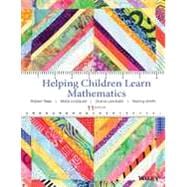The 11th Edition of Helping Children Learn Mathematics is designed to help those who are or will be teachers of mathematics in elementary schools help children develop understanding and proficiency with mathematics so they can solve problems. This text is built around three main themes; helping children make sense of mathematics, incorporating practical experiences and using research to guide teaching. It also integrates connections and implications from the Common Core Standards: Mathematics (CCSS-M).








